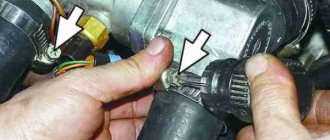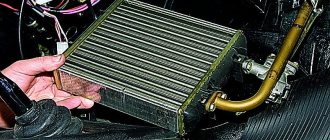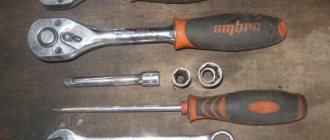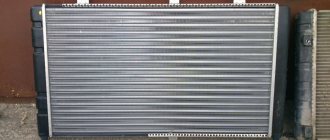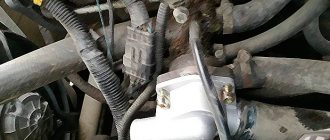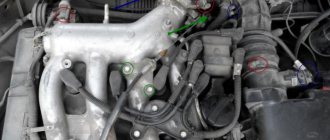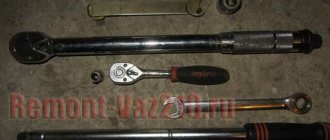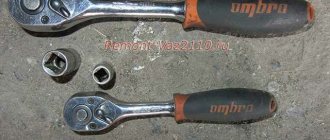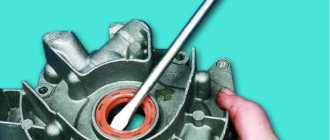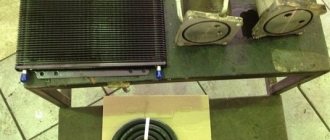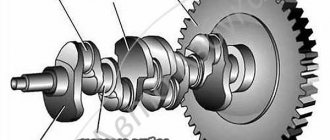The cooling radiator is the most important element in the design of a car, since failure of the radiator leads to the fact that the engine cooling system does not fulfill its task and the engine overheats.
If the radiator is leaking, corroded or clogged:
- the coolant level in the system drops;
- the circulation of antifreeze is disrupted;
- the pressure in the cooling system increases.
The result is a malfunction of the cooling system (ruptured pipes) and overheating of the power plant, which can lead to critical engine failure. In such a situation, it is better to immediately replace a faulty radiator on a VAZ 2110, choosing the right replacement option. Read more in our article.
Removing and replacing the VAZ 2110, 2111, 2112 cooling radiator with your own hands
Sometimes, even after changing the pipes, antifreeze leaks out and accumulates under the radiator.
Also, in such cases, stains and smudges from the coolant are visible on the radiator. To make sure of this, you need to remove and replace the radiator of the VAZ 2110, 2111, 2112. The work is done with your own hands and is not difficult to perform. You will need: a new cooling radiator, a 10″ wrench, a screwdriver, new antifreeze.
Open the hood, disconnect the battery terminal, remove the drain plug on the left side of the radiator and drain all the antifreeze.
We drain the antifreeze from the cylinder block. To speed up draining, unscrew the cap on the expansion tank.
Turn off the radiator fan. For convenience, you can remove the air filter.
Unscrew the bolts on the left side of the radiator.
And also one at the bottom of the radiator
Next, carefully remove the radiator fan.
Unscrew the clamps and disconnect the radiator pipes.
Actually we take out the radiator itself. We replace it with a new one and install it in the reverse order. Fill in new antifreeze.
Video on replacing the cooling radiator VAZ 2110, 2111, 2112
Source
Radiator repair
You can also repair the RO with your own hands, if possible. In other words, if the core, upper or lower tank, or pipes on the RO are damaged, then in this case everything can be repaired yourself. Although this is a very painstaking job, it can still be done with patience, desire and knowledge. So:
- The repair of this element begins with checking the coolant level in the expansion tank. On the expansion tank of the VAZ 2112 there are min/max inscriptions, by which you can determine the norm. If the liquid constantly decreases, then we are probably talking about a leak that can form in the pipes.
- We inspect all hoses and replace any torn ones.
- It is easy to find a crack in the hoses, but finding it in the radiator itself is a little problematic, especially if the crack is small. But today, stores sell special antifreeze additives that, when they get into the radiator, close microcracks. Very convenient and practical.
- If a leak is found in the radiator pipes, it can be eliminated either with sealant, electrical tape, or a cut hose.
Instructions for replacing RO are given here with the aim of helping novice drivers carry out repair work on their own, the price of which today is clearly off the charts in specialized car repair shops. During the operation, it is recommended to view photos and videos - materials that provide practical understanding.
Source: masteravaza.ru
How to replace the radiator of a VAZ-2112 heater with 16 valves of different types
Signs that your car's heating system radiator requires replacement:
- high consumption of coolant (antifreeze or antifreeze) in the vehicle cooling system (antifreeze or antifreeze);
- The heating of the car interior does not work;
- traces of a coolant leak on the asphalt under the heater radiator or leaks in the hoses supplying fluid to the heater;
- the smell of antifreeze in the cabin;
- greasy deposits on car windows, their fogging.
In these cases, first of all, check the tightness of the system hose clamps. Perhaps they are the cause of the leaks.
And now about how to replace the VAZ-2112 heater radiator with 16 valves of different types
New cooling system
The sequence of your actions in this case is as follows:
- First of all, for safety reasons, disconnect the negative terminal of the battery. We drain the cooled antifreeze or antifreeze, first opening the expander cap. To drain the liquid you will need a container with a volume of 4-5 liters.
- Now, after unscrewing the two nuts, remove the wipers from the car.
- Then we dismantle the released protective plastic cover under the windshield, which is secured with 2 nuts and 4 self-tapping screws.
- To access the stove, remove the frill of the car by unscrewing 5 self-tapping screws, 1 screw and 2 nuts located at the bottom, in the middle of the frill, in the area of the steering rack.
- In order to remove the stove, remove the yellow cross brace, if any, as well as the curved bellows of the air filter.
- We pull the chokes off the radiator pipes.
- Then disconnect all electrical wires from the stove terminals.
- At the steering rack, unscrew 2 nuts that secure the heater, 1 nut securing the heater to the body.
- We unscrew the 3 screws connecting the two halves of the stove.
- We take it out by swinging the right side of the stove, first moving it to the right.
- The radiator in the removed half of the stove is secured with 3 screws. We take it out and replace it with a new one, not forgetting to put on the foam seal. We check the operation of the fan and, if necessary, repair it or replace it with a new one.
- Before installing the assembly, it is advisable to rinse the coolant supply hoses with running water.
- Assembly is carried out in reverse order.
Old style cooling system
Such heaters were installed on early 21120 models. You can determine the modification of the system by its appearance, after first removing the frill of the car.
To replace the radiator you need:
- Carry out steps 1, 4-7 for removing the new type cooling system.
- We dismantle the expansion tank of the cooling system.
- We remove the vacuum booster by unscrewing the 2 nuts (17 mm) and carefully (without damaging the brake system pipes) move the brake master cylinder to the side. Remove the vacuum booster pipe.
- Inside the car, unscrew the 4 nuts from the brake pedal studs and, together with the pedal, remove the car's amplifier.
- Thus, we gained access to the heater core, which is secured with three screws. We replace it and reassemble the entire system in the reverse order.
Replacing the cooling radiator - instructions with photos
Dear readers, in this article we will figure out how to change the cooling radiator on VAZ 2110-2112 cars. So, the radiator must be replaced if a coolant leak is detected from it. In general, the engine cooling radiator can be repaired in a special workshop, the whole point is just how much it will cost. Let's get straight to work. This will take approximately 3 hours. We will need:
Perform all work only on a cold engine!
- The first thing to do is drain the coolant;
- Then remove the air filter;
- After this, loosen the clamp of the lower supply hose;
- Disconnect the hose from the lower radiator pipe;
Now loosen the clamp on the upper outlet hose;
Replacing RO
Replacing the cooling radiator VAZ 21124
As mentioned above, replacing the radiator is necessary in the case when its repair is impossible and frequent coolant leaks are detected. RO is checked using special equipment in a workshop, where it can still be “cured”. As mentioned above, places corroded by rust over time can be restored using welding.
VAZ 2112 cooling radiator and its replacement
If the repair does not help, then the RO is replaced as follows:
- First of all, the battery is removed from the car.
- The coolant is drained.
- The air filter is also removed.
- After this, you need to find the clamp that tightens the wire harnesses and unfasten it (in extreme cases, you can cut it and then install a new one).
- In the same manner, unfasten the throttle clamp located on the fan casing.
- Now is the time to loosen the clamps and then disconnect the PO outlet hose from the thermostat. At the same time, it is necessary to remove the RO supply hose from the cooling jacket.
VAZ 2112 removal of cooling radiator
- Now you need to loosen the clamp that secures the steam hose and disconnect it from the expansion tank. After this, remove the fastening clamp from the hose.
- The steam removal hose is pulled out of the clamps, which tighten it with the expansion tank hose and the water pump supply pipe.
- The nut that secures the radiator to the body in the upper part is unscrewed. We are talking about a nut that simultaneously secures the fan casing.
- We tilt the RO towards the engine and remove it upwards. This element must be dismantled along with the fan.
- We disconnect all attachments (hoses) from the RO.
- 2 bolts and nuts hold the casing with the fan. They turn away, and the casing with the fan is separated from the RO.
Note. There should be two lower mounting cushions left on the RO. They must also be replaced without fail if they are torn or have lost their former elasticity.
- A casing with a fan is placed on the new radiator. New pillows are being installed, as was said.
- The RO is installed in place. Poured into the coolant system.
- The replacement process is complete.
Changing the VAZ 2110 cooling radiator with your own hands
Even for people who are quite far from technology, the purpose of a cooling radiator is clear - it removes excess heat from the engine, thereby preventing it from overheating and failing.
However, some time passes, the most important part of the cooling system may fail, or simply leak. Then there is a need to replace the cooling radiator of the VAZ 2110, which can be done not only at a service station, but also with your own hands.
New engine cooling radiator
Device
Any radiator on a car, regardless of its brand, consists of:
The body, which can often be made of aluminum, less often copper, consists of two tanks (one on top, the other on the bottom) and adjacent pipes through which the coolant circulates.
The core is rows of brass tubes soldered to cooling fins. They are located inside the case.
Cooling liquid enters the radiator through the filler plug and is drained through the drain valve, if necessary.
In addition, the power unit for maintaining thermal conditions includes an electric fan and a thermostat.
Radiator and everything about it
Replacing the cooling radiator on a VAZ 2112
The cooling radiator was invented a long time ago, back in the 19th century. Even then, it began to perform the most important functions and ingenious human thought gradually brought it to perfection, and today it is simply impossible to imagine a liquid-cooled car without this element. The radiator, like any mechanism, component, or element of a car, fails over time. But there are special rules that must be followed. Otherwise, the radiator will fail prematurely. Thus, it is prohibited to open the radiator at high coolant temperatures, but some motorists continue to do this.
Thermosyphon effect or water pump
- Any cooling radiator interacts with a pump or water pump, as it is also called. But in old coolants there was no such pump and the coolant entered the radiator in a different way, due to a physical effect called “thermosiphon”.
Note. The thermosyphon effect implies the following: the density of water drops when heated, thereby the liquid begins to tend upward. After this, it enters the radiator through the upper pipe. When water cools, its density increases and the liquid automatically sinks to the bottom of the radiator.
- Over time, due to low efficiency, the thermosiphon effect gradually began to give way to a more advanced system that involved the use of a pump.
Radiator task
Cooling radiator diagram
Needless to say, the most important task of any RO is to remove heat from the engine into the atmosphere. Thus, antifreeze or antifreeze is cooled as it passes through the radiator. After modernizing the RO, the following was achieved:
- RO began to be installed in the most convenient place to ensure heat removal. In particular, in front of the car, which while driving is blown by a strong flow of cold air from the front.
Note. On some cars, the engine is located not in the front of the car, but in the rear. But again, in this case the RO is installed in front, and the entire CO is routed to the engine through the entire body of the car.
- Modernization of the RO made it possible to protect it well in the cold season. We are talking about blinds that are installed in front of the radiator at the production stage of the VAZ 2112 or independently by the owner himself.
What does RO consist of:
- RA always consists of two tanks: upper and lower. They can be metal or plastic.
- CO pipes are installed to these same tanks or compartments.
- RO consists of a core, which is a set of seamless aluminum tubes (tubes can also be made of brass, less often copper). The thickness of these same tubes, or rather their walls, is 0.15 mm or less. Each of the tubes is covered with strips of copper or the same aluminum.
Note. Aluminum radiators are much lighter than brass ones, but they are destroyed more quickly under the influence of mechanical stress. In addition, repairing such radiators is extremely difficult, because it involves welding, which is very difficult to perform. As you know, aluminum requires special welding. And in order to match the performance of a brass radiator, an aluminum one must be made much thicker and larger.
Thermostat
This CO element is very important for the normal functioning of the RO. It supports the main function of the RO, that is, it helps maintain a constant coolant temperature. In hot weather, one thermostat is not enough and then a fan or even several fans are used, which are additionally installed in the VAZ 2112.
Causes of engine overheating
The reasons for overheating of the VAZ 2110 engine include, first of all, the insufficiently efficient operation of the cooling system. The reasons may be:
- The radiator pipes are clogged. A thing that is rarely seen today, and only when using coolant of extremely low quality. In this case, replacing them will help;
- Low coolant level due to leakage at the attachment points of the pipes or cracks in the pipes themselves. Need to replace fasteners or pipes;
- Housing contamination. Here you should take into account a small detail: the whole car, the radiator in particular, requires care. It should not be allowed to “overgrow” with dirt, fallen leaves, or other debris. Because of this, the efficiency of its work is significantly reduced;
- The radiator is leaking. It is necessary to remove it in order to decide based on the location, size of the leak, and general wear and tear of the unit whether it needs repair or replacement.
Design
Diagram of the engine cooling system
The structural elements of the cooling unit being considered today are:
- Two body parts;
- Pipes;
- Cores;
- Drain valve located at the bottom of the housing;
- Filler plug at the top of the housing with two valves (inlet and outlet).
Also in fairness, it is worth including a thermostat and an electric fan in the cooling system, which play an important role in cooling the engine.
- The housing consists of two tanks with adjacent pipes through which coolant passes.
- The core is a series of brass tubes that are soldered to the cooling fins. They can be found inside the case.
- The fill plug allows coolant to be redirected to the radiator, and the drain valve allows the coolant to drain when needed.
Model selection
For the VAZ 2110 you can choose either aluminum or copper radiators. To a large extent, the choice depends on what result you need: saving money or durability and reliability.
Their disadvantages and advantages:
- Aluminum. Lightweight, relatively cheap, the price depends on the manufacturer: - Luzar (2110-8101060) - about 1000 rubles; - Pramo (2110-1301012) - retail approximately 1600 rubles. But its thermal conductivity interferes, and it cools the engine worse. In addition, it is subject to fairly rapid corrosion; it takes less time for it to flow; Aluminum radiator cooling
- Copper. It is heavier, significantly more efficient in its cooling characteristics, and lasts longer, since the copper body is less susceptible to corrosion. For it to flow, mechanical action (impact, etc.) is most often required. The disadvantage is that its price is higher, about 5,000 rubles, for a two-row one, with an increased efficiency of 40%. Copper cooling radiator with 40% increased efficiency
Dismantling and installation
To remove the cooling radiator from a VAZ 2110 with your own hands, you must:
- Drain the coolant through the bottom plug;
- Remove the battery as it is in the way;
- On the injection VAZ 2110, it is also necessary to remove the air filter;
- The upper mount to the frame must be disassembled, simultaneously releasing the fan;
- Remove the electric fan;
- Remove two hoses - for steam supply/discharge;
- Tilt the radiator towards the engine and remove.
That is, removal is quite simple. Now, if the radiator leaks slightly, but is not severely damaged by corrosion, you can repair it. Otherwise, replace it. When choosing a new radiator for a VAZ 2110, be sure to take into account the model of the previously installed one so that the new one fits perfectly.
When installing, make sure that the rubber pads on which the body rests with the lower part fit firmly into the holes on the cross member.
Next, you need to fill in the coolant (you can use the old one by filtering it), and then start the engine.
Source
Why does the engine overheat?
The engine on a VAZ 2110 can overheat for various reasons. The first priority is a decrease in the efficiency of the cooling system. Why does it stop working properly?
- The cooling system pipes may become clogged. Today such a situation is rare. Mainly provided that very low-grade coolant is used for CO. There is only one way out - change the pipes and use normal coolant.
- Various smudges and leaks lead to a decrease in the coolant level. Here you will have to replace all the components that are causing the leak.
- The housing is dirty. Over time, debris, dirt, leaves, insect corpses, and so on accumulate on the radiator housing. This negatively affects work efficiency. Therefore, be sure to periodically clean the exterior of the housing.
- Radiator leak. In such a situation, you will have to remove it, assess the extent of the damage and decide whether to repair it or replace it with a new one.
